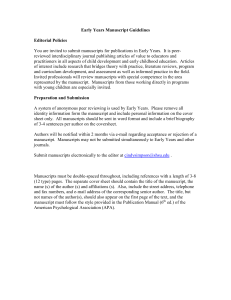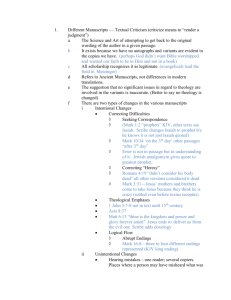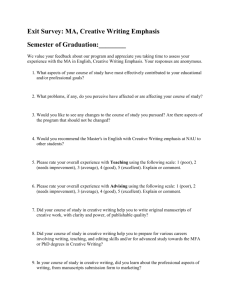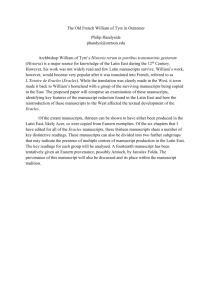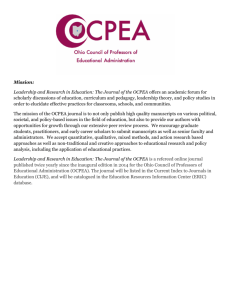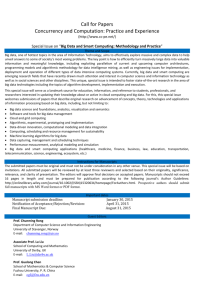Script and Ornament in Renaissance Illuminated Manuscripts
advertisement
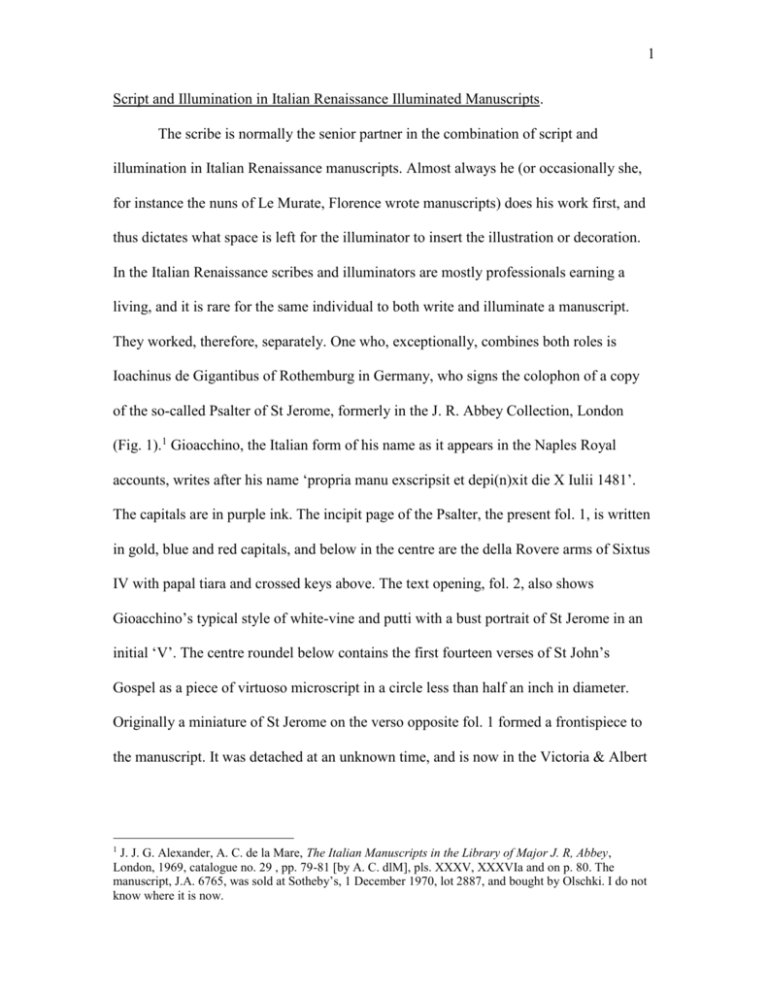
1 Script and Illumination in Italian Renaissance Illuminated Manuscripts. The scribe is normally the senior partner in the combination of script and illumination in Italian Renaissance manuscripts. Almost always he (or occasionally she, for instance the nuns of Le Murate, Florence wrote manuscripts) does his work first, and thus dictates what space is left for the illuminator to insert the illustration or decoration. In the Italian Renaissance scribes and illuminators are mostly professionals earning a living, and it is rare for the same individual to both write and illuminate a manuscript. They worked, therefore, separately. One who, exceptionally, combines both roles is Ioachinus de Gigantibus of Rothemburg in Germany, who signs the colophon of a copy of the so-called Psalter of St Jerome, formerly in the J. R. Abbey Collection, London (Fig. 1).1 Gioacchino, the Italian form of his name as it appears in the Naples Royal accounts, writes after his name ‘propria manu exscripsit et depi(n)xit die X Iulii 1481’. The capitals are in purple ink. The incipit page of the Psalter, the present fol. 1, is written in gold, blue and red capitals, and below in the centre are the della Rovere arms of Sixtus IV with papal tiara and crossed keys above. The text opening, fol. 2, also shows Gioacchino’s typical style of white-vine and putti with a bust portrait of St Jerome in an initial ‘V’. The centre roundel below contains the first fourteen verses of St John’s Gospel as a piece of virtuoso microscript in a circle less than half an inch in diameter. Originally a miniature of St Jerome on the verso opposite fol. 1 formed a frontispiece to the manuscript. It was detached at an unknown time, and is now in the Victoria & Albert 1 J. J. G. Alexander, A. C. de la Mare, The Italian Manuscripts in the Library of Major J. R, Abbey, London, 1969, catalogue no. 29 , pp. 79-81 [by A. C. dlM], pls. XXXV, XXXVIa and on p. 80. The manuscript, J.A. 6765, was sold at Sotheby’s, 1 December 1970, lot 2887, and bought by Olschki. I do not know where it is now. 2 Museum, London.2 No-one could claim that Gioacchino though a competent scribe was outstanding as an illuminator. The phraze ‘manu propria’ may be significant, but I have not been able to establish how common or uncommon it may be.3 Another example of a scribe/illuminator is Raphael Berti of Pistoia in a manuscript of Juvenal’s Satires written in Parma in 1464, also formerly in the Abbey collection.4 He signs his colophon twice, above ‘scripto et miniato’, and below ‘scripsit atque miniavit’, and he gives the date 1464. The illumination consists of conventional white-vine borders and initials for each of the Satires. A third example is the much more prolific and successful Bartolomeo Sanvito. Sanvito’s colophons of the Epistolary and Evangeliary, which he wrote towards the end of his life in 1509 for the Collegiate Church of Santa Giustina at Monselice near Padua, of which he was a Canon, read ‘manu sua impensaque conscripta ornataque’, ‘by his hand and at his expense written and ornamented’ (Fig. 2).5 The extent of Sanvito’s activity as an illuminator is a disputed question, but in my opinion more normally Sanvito collaborated with other artists, especially with Gaspare da Padova (or ‘Romano’) in the later 1470’s and 1480’s, when both men were part of the household of Cardinal Francesco Gonzaga. Gaspare died at an unknown date, but probably c. 1493, due to a fall from the scaffolding of the palace on 2 London, Victoria and Albert Museum, Box I 34a (5721). T. De Marinis, La Biblioteca Napoletana dei Re d'Aragona, I, Milan, 1952, pp. 61-2 and pl. after p. 150. A colour image is available on the Museum web site. 3 It is not found for example in R. Goffen, ‘Signatures: Inscribing Identity in Italian Renaissance Art’, Viator, XXXII, 2001, pp. 303-70. 4 J.A. 6769. Alexander, de la Mare (as in n.1), 1969, catalogue 55, pp. 151-2 [J.J.G.A], pls. LXXb and p. 152. Sold Sotheby’s, 1 December 1970, lot 2882, now Rome, Biblioteca nazionale Vittorio Emanuele, Ms. 1429 5 A. C. de la Mare, L. Nuvoloni, with contributions by S. Dickerson, E. C. Erdreich, A. Hobson, Bartolomeo Sanvito. The Life and Work of a Renaissance Scribe, The Handwriting of the Italian Renaissance Scribes II, ed. A. Hobson, C. de Hamel, Association Internationale du Bibliophile, 2009, cat. 121. pp. 368-71. 3 which he was working for the Cardinal Riario (cr. 1477, d. 1521), later to become the Cancelleria.6 I would hypothesize that it was probably in the early to mid 1480’s that Sanvito began to act himself as an illuminator and in a more ambitious way. It has always seemed to me that the ‘Sanvito illuminator’ as I called him in the Abbey catalogue in 1969, alias Sanvito himself, as opposed to the ‘Master of the Vatican Homer’, alias Gaspare da Padova, is distinguishable by his weaker figure drawing as it can be seen in the signed Epistolary and Evangeliary.7 Though Ellen Erdreich has argued for Sanvito being responsible for both oeuvres, the two styles occur in my view not only in the same manuscript but on the same page. This can be clearly seen in the frontispiece of the Ps.Aristotle, de animalibus, with the arms of Pope Sixtus IV. This was written by an anonymous scribe but with one line of small blue capitals written by Sanvito himself, and it was dated c. 1480-83 by Albinia de la Mare.8 The main illumination on fol. 8r is attributable to Gaspare, but the much weaker angels supporting the Papal arms are by Sanvito in my opinion. By the time Sanvito illuminated the twelve miniatures in the Virgil for Lodovivo Agnelli, c.1483-5 he was already more practiced, but the stylistic weaknesses remain.9 Obviously the size of a manuscript was in a major degree dictated by the length of the text or texts it was to contain. A larger folio will be written in two or occasionally For the documents on Sanvito and Gaspare in the cardinal’s household see D. Chambers, A Renaissance Cardinal and his Worldly Goods: the Will and Inventory of Francesco Gonzaga (1444-1483), London, 1992. See also G. Toscano, ‘Gaspare da Padova e la diffusione della miniatura “al antica” tra Roma e Napoli’, in exhibition catalogue La miniatura a Padova dal Medioevo al settecento, a cura di G. Baldassin Molli, G. Mariani Canova, F. Toniolo, Padua, 1999, pp. 523-31. 7 Padua, Biblioteca Capitolare, Mss. E. 26-7. de la Mare, Nuvoloni (as in n. 5), pp. 368-71, cat. 121. 8 Vatican, Biblioteca Apostolica Vaticana, Vat. lat. 2094. Exhibition catalogue, The Painted Page. Italian Renaissance Book Illumination 1450-1550, Royal Academy of Arts, London, Pierpont Morgan Library, New York, 2004-5, cat. 38 (J. J. G. Alexander). de la Mare, Nuvoloni (as in n. 5), p. 205. 9 London, British Library, King’s 24. de la Mare, Nuvoloni (as in n. 5), pp. 266-7, cat.74. 6 4 three columns. In some manuscripts ruled for two columns of script the central space between the columns becomes an additional location for ornament which is usually quite narrow. An example is the Breviary of Leonello d’Este. The illumination of this is very fully documented between 1441 and 1449 in the D’Este accounts, and it is therefore all the more tragic that soon after being sold at auction in London in 1958 the manuscript was dismembered in America. Single leaves are now widely scattered. They continue to turn up in libraries and collections, and still appear sporadically on the market [Fig. 3]. Federica Toniolo has inventoried those so far known and suggested attributions to the four illuminators named in the payments.10 These are Giorgio d’Alemagna, who was paid for fifty-three ‘quinterni’ (gatherings), Matteo de’ Pasti, better known as a medallist, Guglielmo Giraldi, and Bartolomeo di Benincà.11 The manuscript had a total of five hundred and twelve folios when sold, and if, as seems to have been the case, all pages were illuminated it was an extremely ambitious project. It is not uncommon for such projects to be left incomplete, often no doubt for lack of funds. A Breviary is a long text and thus a thick volume, but it needed to be portable, so it is commonly relatively restricted in height and width, and written in small script.12 Too long a line is uncomfortable for the eye, but too short a line makes the eye jump unnecessarily frequently to the next line. The size of the letters also obviously makes a difference in calculating the size of the page and the length of the manuscript. In some Christie’s, London, 8 December 1958, lot 190. Ten leaves of the beginning of the Sanctorale were acquired by Philip Hofer and are now Cambridge, Massachusetts, Houghton Library, Ms. Typ. 301. They measure approximately 272 x 202mm. For colour reproductions see the exhibition catalogue, Cosmé Tura and Francesco del Cossa. L’Arte a Ferrara nell’età di Borso d’Este, Ferrara, 2008, cats. 31-2. 11 F. Toniolo, ‘Il lungo viaggio del Breviario di Lionello d’Este tra le due sponde dell’Atlantico’, Medioevo: arte e storia (Atti del Convegno internazionale di studi, Parma, 18-22 settembre 2007), a cura di A. C. Quintavalle, Milan, 2008, pp. 564-77. 12 My friend, Professor Nigel Morgan, who has been working on the catalogue of the Italian illuminated manuscripts in the Fitzwilliam Museum, Cambridge, to be published shortly, commented in discussion after this paper on the very complex problems of textual lay-out faced by a scribe writing a Breviary. 10 5 books, for example twelfth-century monastic lectern Bibles and especially the choir books for the sung parts of the Mass and Office, which had to be read by members of the Choir grouped around the badalone, both the page and the letters are significantly larger. Such manuscripts did not need to be portable in the same way as a Bible for private use, or as a Book of Hours. This also required the illuminator to insert larger miniatures and initials. His work becomes nearer in scale to that of a panel painter. It is the other end of the scale to the process of miniaturization in small manuscripts such as Books of Hours. The text obviously also affected both the type of script used and the forms of the decoration in a manuscript. In the Renaissance the liturgical texts, especially Missals and Breviaries, are always in the fifteenth century, so far as I know, written in gothic script (gotica textualis).13 They normally also have the traditional style of foliage borders and initial decoration, similar to that used in the preceding century and even earlier. Books of Hours which are not used in the liturgy and which were owned in large numbers, though not exclusively, by the laity, are in the main also written in gothic script and decorated with Gothic style ornament. Humanistic script is used later in the century, for example by Sanvito and by Pierantonio Sallando of Bologna to name only two prominent scribes. I know of no statistics as to relative numbers, and in the examples I know of I am not aware of this affecting the type of illumination used. A typical Book of Hours in formal Gothic script with ‘Gothic’ style borders is that illuminated by the Florentine artist, Zanobi Strozzi, now in the Walters Art Museum, Baltimore.14 In this example Strozzi 13 Exceptions are some service books written in the cancelleresca formata newly introduced in the 16th century. An example is the Towneley Lectionary illuminated by Giulio Clovio for Cardinal Alessandro Farnese perhaps about 1550-60. The identity of the scribes is unknown. See Nicolas Barker in J. J. G. Alexander et al., The Townely Lectionary, Roxburghe Club, 1997, pp. 38-49. 14 Baltimore,Walters Art Museum, W. 767. Exhibition catalogue, Painting and Illumination in Early Renaissance Florence 1300-1450, Metropolitan Museum of Art, New York, 1994, cat. 53 (C. B. Strehlke). 6 uses the ornamental style traditional for liturgical manuscripts in Florence known as the ‘Angeli’ style, but in another Hours, also written in Gothic script, white-vine borders are found, though whether by Strozzi himself or another seems uncertain.15 Neither Hours is dated but both are likely to be of c. 1445-55. As to statistics of Renaissance non-liturgical and non-religious manuscripts written in humanistic script as opposed to Gothic script, they would be an even harder task to compile, and I am not aware of any even limited attempt to gather relative numbers for either a particular text or for a particular geographical area. Nor can one quantify the prevalence of white-vine illumination in such texts. I think in any case it is likely that there are too many ancillary factors to make any such statistics meaningful. However, in Florence, as Albinia de la Mare observed, there was a change of fashion from about 1465 to 1470 whereby the white-vine borders gave way to hairspray borders with foliage, flowers and fruit similar to those in liturgical and religious manuscripts. These are what Albinia de la Mare called ‘flower borders’.16 They usually also include numerous animals, birds and humans, especially putti, but also classical mythological figures such as centaurs and satyrs. One can, therefore, risk a generalization that the illuminators generally followed the lead given by the scribe in choosing a style of script, whether ‘gothic’ or ‘humanistic’, in choosing their own style of decoration, but then qualify this immediately by saying ‘but not always’. The illuminator evidently retained a certain freedom and 15 16 Florence, Biblioteca Riccardiana, Ms. 457. Painting and Illumination (as in n.14), Fig. 133. A. C. de la Mare, A. C., ‘Vespasiano da Bisticci as Producer of Classical Manuscripts in Fifteenthcentury Florence’, Medieval Manuscripts of the Latin Classics: Production and Use, eds. C. A. ChavannesMazel, M. M. Smith, Los Altos Hills, 1996, p. 194. 7 independence in his decoration, even if, as already stated, he is necessarily confined by the space left to him on the page for his miniatures, borders or initials. Albinia de la Mare was, of course, mainly concerned with scribes writing humanistic script. Anything she has to say about illumination should be taken seriously, however, for she was always prudent and cautious in expressing her opinion on art historical matters. We worked closely together as colleagues in the Department of Western Manuscripts under Richard Hunt, the Keeper, while I was at the Bodleian Library from 1963-1971. And she was especially involved in the second volume of Otto Pächt’s catalogue of the illuminated manuscripts in the Bodleian Library, the Italian volume, which came out in 1970. When we collaborated on the catalogue of Major J. R. Abbey’s manuscripts, published in 1969, the collaboration was even closer, since though we signed our entries she wrote most of the descriptions of script in the individual entries and I of the illumination. The areas of the manuscript in which the work of the scribe and the illuminator approach each other most closely and may even overlap on the page are, first, textual beginnings (incipits), especially title-pages and the headings to sections within a text, and secondly, and less often, endings (explicits). These include the initials which mark the beginning of a book or a chapter or a sentence. The scribe very often gave guidance for an initial in the form of a small guide letter written either in the margin or in the space left open. It was meant to be erased or painted over, but not infrequently that was not done. In any case mistakes sometimes occur either by the scribe or by the illuminator. Decoration at the explicit is less frequent. Sanvito and other antiquarian minded scribes were fond of finishing the explicit as an inverted pyramid and then drawing a small leaf 8 copying that often found on Roman carved inscriptions [Fig. 2].17 Giulio Clovio painted a more ornate frame to surround the scribal colophon in the Farnese Hours [Fig. 4].18 I would suppose, however, that the actual letters in white were written by the anonymous scribe, who, as Vasari fortunately tells us since he does not sign his own name, was Francesco Monterchi. Catchwords for gatherings, which were sometimes ornamented by scribes, would be included in my category of endings. At the beginning of this paper I stated that the scribe made the primary decisions. But that is a little too simple. We need to take into account assumptions which grew up from practices which were established by custom. They hardly needed to be articulated, therefore. For instance illuminators commonly used the ruling lines drawn by the scribe for his text as a basis for the frames of their miniatures. Secondly, we need to think of the possibilities of additional dialogue with the cartolaio (stationer), either with or without the patron’s consultation. The patron might also have an intermediary agent to give instruction to the scribe and illuminator, or the agent might instruct the cartolaio. In other words there were many ways in which oral instruction might have reached the illuminator and left no trace. Money must surely have entered the discussion at some point, since the patron, however rich, must have needed to know, even if only approximately, what he was going to have to pay, when he initially commissioned a manuscript. Though we have a few surviving contracts they are very few, and even allowing for many being destroyed, I think in most cases agreements must have been 17 18 J. Wardrop, The Script of Humanism, Oxford, 1963, pls. 2, 9, 21, 52. New York, Morgan Library, M. 69. Farnese Book of Hours with illuminations by Giulio Clovio Croata (Complete colour facsimile edition of the MS M.69 of the Pierpont Morgan Library New York), commentary W. M. Voelkle, I. Golub, preface M. Begović, Zagreb, Graz, 2001. 9 verbal.19 Where contracts do exist the matters most stressed are completion on time, and the use of good materials. Directions as to illumination are infrequent, and hardly ever specific as to content. We have two forms of surviving physical evidence which shed light on the process in addition to the few surviving contracts. The first are records regarding payment found in the actual books themselves. The second are the financial accounts of individuals, for example the Kings of Naples, and institutions, for example the Opera of the Cathedral of Siena. From these we get an idea of terminology and of rates of payment We know from these sources that the title-pages or frontispieces, which were not necessarily at this stage such distinct entities as they later became in the printed book, were referred to as a ‘principio’. For example in the contract for the Bible of King Manuel of Portugal, which was drawn up in Florence by the Florentine merchant Chimenti (Clemente) di Cipriano di Sernigi with the illuminator Attavante in 1494, each of the eight volumes was to have ‘un principio colla rubrica a riscontro” [Fig. 5].20 I understand the word ‘principio’ to mean the verso and facing recto, what we should call an ‘opening’. These were to cost twenty-five ‘ducati XXV larghi d’oro’. 19 J. J. G. Alexander, Medieval illuminators and their methods of work, New Haven, London, 1992, Appendix 1. 20 Lisbon, Arquivos nacionais, Torre do Tombo, Ms. 161/1-8. The opening of volume 6 is attributable to a different Florentine illuminator, Monte di Giovanni di Miniato, who is not mentioned in the contract. The Painted Page (as in n. 8), cat. 1 (J. J. G. Alexander). A publication with good colour reproductions of each principio unfortunately does not reproduce volume 8 containing the Sentences of Peter Lombard. M. de Albuquerque, A. C. Cardoso, A Bíblia dos Jerónimos, Milan, Lisbon, 2004. For the contract see Alexander (as in n. 19), pp. 181-2. I am most grateful to Alice Wohl for discussing the Bible with me, for sharing her knowledge of Portugese history of the period, and for help in translating literature in Portugese. She has convincingly suggested to me that the Sernigi brothers, Clemente and Girolamo, intended the Bible as a gift to curry favour with Manuel who was not yet king when the project started. Their aim was to participate in the extremely lucrative trade opening up between Portugal and India. See in particular P. Peragallo, La Bibbia dos Jeronymos e La Bibbia di Clemente Sernigi. Studi Comparativi, Genoa, 1901. 10 The eight volumes are kept to-day in the Arquivo Nacional da Torre do Tombo in Lisbon. Albinia de la Mare commented on this Bible in an article published in 2000.21 The contract specifies as the scribe of the Bible Frater Jacobus Carmelitanus, whom she identified as probably the scribe who signed a volume written for Matthias Corvinus, King of Hungary, in Apri 1490.22 She attributed the script of volume 5 of the Bible to him. Volume 1 was signed by the scribe, Sigismondo dei Sigismondi on 11 Dec. 1494 and volume 2 was signed by Alessandro da Verrazzano in August 1495. Albinia de la Mare also attributed the script of volumes 4 and 6 to Alessandro and that of volumes 3 and 7, unsigned but dated respectively 1496 and 1497, to Niccolò Mangona, a productive Florentine scribe whom she had identified from a single signed manuscript. The openings of each volume follow the arrangement of volume 1 of the Bible in that on the verso there is a form of architectural structure with a space on which the contents of the volume is written in gold capitals in blue. On the opposite recto a quarterpage miniature shows St Jerome, in most of the volumes as a scribe at work in his study, but in volume 2, in prayer outside his cave before a Crucifix, and in volume 6 presenting his finished work to Pope Damasus. In volume 8, the Peter Lombard, there is a miniature of the Trinity. The borders match in design across the openings, and in each the arms of Portugal are prominently placed in the middle of the lower border. The scribes began the biblical text, which is combined with the gloss of Nicholas de Lyra, under the miniatures on the rectos, writing it in two columns. The scribes probably copied one of the Bibles recently printed in various editions in Italy, which similarly combined text and gloss. This, incidentally, demonstrates how a manuscript is still at this point in time a much A. C. de la Mare, ‘Notes on Portuguese patrons of the Florentine book trade in the fifteenth century’, Cultural links between Portugal and Italy in the Renaissance, ed. K. J. P. Lowe, Oxford, 2000, pp. 167-81. 22 Florence, Biblioteca Medicea Laurenziana, 21.18. de la Mare Ias in n. 21), 60, n. 60. 21 11 more prestigious gift than a printed book. The artist filled the space between the columns with a narrow band of foliage ornament. Therefore on these pages the script and the illumination are combined and it is unclear to me exactly what the sequence of operation would have been. I would suggest as a hypothetical sequence that a first stage was a drawing rather similar to one in the Morgan Library [Fig. 6],23 or to another, now in private hands which has been attributed recently by Pier Luigi Mulas to the Milanese artist, Giovanni Giacomo Decio.24 Then in the Bible the illuminators coloured blue the relevant spaces and handed the leaves back to the scribes to insert the written parts on verso and recto, the incipits being written in capitals and the text in humanistic minuscule, and both being written in gold. Then presumably the remaining leaves of the gathering were written before the opening was handed back to the illuminator, Attavante or Monte, to complete any remaining illumination needed in the gathering. The miniatures of the principio could have been executed before or after the text was written on the verso and recto. There is a let-out clause for Attavante should the scribes fall behind on their deadlines. Interestingly the contract mentions that on the completed sample which had been provided the arms were still to be included, and it also implies that Attavante is going to insert them. In this and most other cases it remains uncertain whether a model was provided of the blason. In manuscripts quite frequently space is left for coats-of-arms which were never inserted, and it has generally been assumed that such manuscripts are for speculative sale, rather than made for a specific patron. This seems probable enough, 23 New York, Morgan Library, 1979.13. The Painted Page (as in n. 8), cat. 107 (J. J. G. Alexander). Sold Les Enluminures, Paris, 1998, cat. 41. P. L. Mulas, Giovanni Giacomo Decio, il miniatore dei corali di Vigevano, Vigevano, 2009, p. 193. 24 12 but, like so much else about the processes of illumination, cannot be certain in any particular case. The initials in the Bible are listed in the contract by the number of lines they fill and were to be paid accordingly, which is quite normal. A recently discovered example is in a printed book, a copy of Orosius, Historiae adversus paganos, printed by Herman Lichtenstein in Vicenza c. 1475.25 It contains a principio attributable to the illuminator, Giovanni Vendramin, who was active in Padua where his father was bidello to the University, and in Ferrara. The list is written on the last verso of the printed text of the Orosius [Fig. 7] and specifies: ‘140 lettere, 7 doro et uno principio’. These respectively are the initials to the chapters, which are capital letters in coloured ink of two, three or four lines in height, the initials to the books of the text, which are of seven lines and in burnished gold on coloured grounds, and the architectural frontispiece, or ‘antiporta’ as scholars in Italy term it. In an earlier article I have argued that Bartolomeo Sanvito as scribe may have sketched the faceted initial letters in certain manuscripts whose illumination was left incomplete, whether intending them for coloring by himself or by someone else.26 It seems likely enough that this would have happened in other Renaissance manuscripts. It 25 Cambridge, Trinity College, Grylls 3.349, where it was kindly brought to my attention by Dr David McKitterick. J. J. G. Alexander, ‘A Copy of Orosius Historiae adversus Paganos’, printed by Herman Lichentstein in Vicenza ca. 1475 with illumination attributable to Giovanni Vendramin’, Viator, XLIII, 2012, pp. 289-300. Unfortunately I have so far been unable to identify the arms inserted on the architectural frontispiece painted by Vendramin. For an excellent general account of the economics of manuscript production see A. Melograni, ‘The illuminated manuscript as a commodity: production, consumption and the cartolaio’s role in fifteenth-century Italy’, The Material Renaissance, eds. M. O’Malley, E. Welch, Manchester, 2007, pp. 207-227. 26 J. J. G. Alexander, `Initials in Renaissance Illuminated Manuscripts: the Problem of the So-called ‘littera mantiniana', in Renaissance- und Humanistenhandschriften, ed. J. Autenrieth, U. Eigler (Schriften des Historischen Kollegs, Kolloquien, 13), Munich, 1988, pp. 145-55. de la Mare, Nuvoloni (as n n. 5), p. 194. 13 would have as it were extended the practice of inserting guide letters mentioned above. Another instance of either overlapping roles or some other form of collaboration between scribe and illuminators occurs in several manuscripts whose titles are painted as if carved inscriptions on wall-plaques. A copy of Martial’s Poems, another manuscript formerly in the J. R. Abbey collection, is an example [Fig. 8].27 The question is whether the illuminator, who has not been identified, designed the letters here as well a painting them, or whether he followed letters drawn in the space by the scribe. Unfortunately there is some later damage to them in this particular manuscript. Another type of initial, which occurred very commonly in illuminated manuscripts and which can be said to lie between calligraphy and illumination in both technique and execution, is the so-called penwork initial. In their simplest forms these were no doubt normally executed by the scribes, or perhaps by apprentices or assistants of the illuminators. Sometimes, however, they were clearly executed by specialists known for this particular skill. One such was Guiniforte da Vicomercato, that is Vimercate a place near Milan, and he has left us a signed pattern-book of such initials. 28 He also signed his name in initials in various choir books.29 Exceptionally beautiful and imaginative penwork borders and initials including animals and human figures occur in a Missal dated 1463. These have been attributed to a well-documented illuminator, Franco 27 J.A. 3223. Alexander, de la Mare (as in n. 1), pp. 114-5, cat. 48 (A.CdlM), colour pl. D, pl. LVIIb. Other examples of similar such fictive inscriptions are listed there. The Martial was sold at Sotheby’s, 4 June 1974, lot 2932. Its present whereabouts is unknown to me. 28 Bloomington, Indiana, The Lilly Library, Ms. Ricketts 240. The Painted Page (as in note 8), cat. 109 (J. J. G. Alexander). 29 Guiniforte also signed initials in choir books from Ferrara. Bartolomeo di Boniforte da Vimercate, who signed penwork for the Badia in Fiesole, and in choir books from Santa Maria in Porto, Ravenna, Biblioteca Classense, Cod. 598-9, was no doubt his son. See Biblioteca Classense Ravenna (Le Grandi Biblioteche d’Italia), a cura di A. Dillon Bussi, C. Claudiani, Florence 1996, pp. 128-31. Dizionario biografico dei miniatori Italiani. Secoli IX – XVI, a cura di M. Bollati, Milan, 2004, pp. 62-3 (M. Bollati), and pp. 338-42 (G. Z. Zanichelli). Contemporary documents refer to ‘letere di penna fiorite’ equivalent to the French term ‘fleuronée’ and the English term ‘flourished’. 14 dei Russi, who was born in Mantua and worked on fully painted miniatures, borders and initials in the great Bible of Borso d’Este, which was started in 1455 and completed in 1465. In 1463 Franco may still have been in Ferrara or have moved to Venice. Later still he worked in Urbino.30 The danger of setting up a binary as I have done here of script and illumination is, of course, oversimplification. Many other examples of co-operation and overlapping between scribes and illuminators could be given, and we should also acknowledge that much of the evidence of their working procedures is irretrievable. My aim has been, however, to emphasize how the two professions, even though they were generally separate at this time, of necessity overlapped. It can be argued in fact that this dynamic interaction was one of the most creative features of the hand produced book throughout its history. Jonathan J. G. Alexander. Sherman Fairchild Professor of Fine Arts emeritus. Institute of Fine Arts. New York University. [de la Mare Publication May 8, 2012 5084 words including footnotes.] Illustrations: Alexander, ‘Script and Illumination’ Fig. 1. Whereabouts unknown. Former J.A. 67665, fol. 29r. Psalter of St Jerome. Colophon of Gioacchino ‘de Gigantibus’. Rome, 1481. 30 New York, New York Public Library, Spencer Collection, Ms. 61. The Splendor of the Word. Medieval and Renaissance Illuminated Manuscripts at the New York Public Library, J. J. G. Alexander, J. H. Marrow, L. F. Sandler, New York, 2005, pp. 182-6, cat. 37 (F. Toniolo). 15 Fig. 2. Padua, Biblioteca Capitolare, Ms. E. 27, fol. 34v. Evangeliary of Monselice, near Padua. Colophon of Bartolomeo Sanvito. Padua, 1509 Fig. 3. Private collection, U.S.A. Breviary of Leonello d’Este. Detached leaf. Ferrara, c. 1441-9. Fig. 4. New York, Morgan Library, M. 69, folio 112v. Farnese Hours. Colophon of Giulio Clovio. Rome, 1546. Fig. 5. Lisbon, Arquivos nacionais, Torre do Tombo, Ms. 161/1, fols. 3v-4r. Opening of Bible of King Manuel of Portugal. Signed by Sigismondo dei Sigismondi. Florence, 1495. Fig. 6. New York, Morgan Library, 1979.13. Preliminary sketch for a frontispiece of a manuscript or printed book. Rome(?), late 15th or early 16th century. Fig. 7. Cambridge, Trinity College, Grylls 3.349. Orosius, Adversus Paganos.. Flyleaf with totals of decoration for payment. Printed by Herman Lichtenstein. Vicenza or Padua, c. 1475. Fig. 8. Whereabouts unknown. Former J. R. Abbey collection, J.A. 3223, fol. 1r. Martial, Poems. Ferrara (?), c. 1467.
